Screening Week
Sat, June 22, from 4pm to 8pm
_still_web-32bd0b8c.jpg)
Annabelle Craven-Jones (GB, 1977)
PRESENCE OF MIND (IMAGING), 2011
Single channel colour video with electronic voice, 2:46 min, loop, edition 3+1 AP
Courtesy Cruise & Callas, Berlin
Central to Annabelle Craven-Jones' work is the aspect of self-imaging. The process of self-imaging is often applied by herself in her works, reflecting on an emotionally led society and an increased therapy and internet culture. Her video “PRESENCE OF MIND (IMAGING)” implements the techniques applied in psychotherapy into an aesthetic practice. It belongs to a whole body of work, which uses a standard scanner. Here, the sensing light of the scanner is the only thing the viewer can see, making him the objective of the scanning-process. The viewer is asked by the self-help meditative text uttered by a computer voice to look into oneself, thereby scanning his body and mind. "Both meditative, penetrating and smug it draws you into its droney-tech-drawl, promising to produce a more holistic sense of self.” (Sacha Waldron, curator, Wysing Arts Centre, Cambridge, 2012)
_still_web-69a19463.jpg)
Annabelle Craven-Jones
I AM ALIVE (INTERFACE), 2011
Single channel video with audio, 3:37 min, loop, edition 3+1 AP
Courtesy Cruise & Callas, Berlin
“I AM ALIVE (INTERFACE)” also shows the artist attempting to enact the process of ‘imaging’ with an ordinary computer scanner. The video shows how the artist scans herself with a scanner, thereby rising a whole complex of questions about the self-portrait mode, about the relation between reality and image. The techniques deployed for the scanning process reference current techniques in medicine as well as techniques in psychology and psychotherapy.
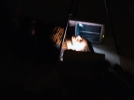
Annabelle Craven-Jones
RE: I AM ALIVE (INTERFACE), 2012
Single channel colour video, 1:54 min, loop, edition 3+1 AP
Courtesy Cruise & Callas, Berlin
The video "RE: I AM ALIVE (INTERFACE)" is a reaction to the artist's video “I AM ALIVE (INTERFACE),” in which the artist scanned her body. "RE: I AM ALIVE (INTERFACE)" re-presents the former work with a shift in perspective: it is not the object of the scanning process which is in the foreground, but the act of scanning itself seen from a different perspective. Here, Craven-Jones takes up the triangular principle, which can often be found in therapy situations. Contrary to “I AM ALIVE (INTERFACE),” which shows an unedited sequence, the footage here becomes reflexive material as it is analyzed by the artist’s editing process.
Sun, June 23, from 4pm to 8pm
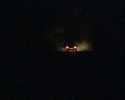
Annabelle Craven-Jones
from a question on leaving, 2007
Single channel colour video, 3:50 min, loop, edition 3+1 AP
Courtesy Cruise & Callas, Berlin
Another body of work of Craven-Jones deals with the complexity of family - a central element of psychotherapy. The protagonists in “from a question on leaving” are the artist and her sister. Craven-Jones films her sister drive away and return to her, leaving the artist alone in the dark with only her camera. The disappearing back lights of the car reference the road movie genre with its theme of formation and transformation of identity. The work also reflects on everyday acts that infer modes of escapism and estrangement. Thus, the performative and poetic act of leaving inevitably evokes the thought about the return of the person, who has just left. Craven-Jones focusses on the discrepancy that arises from these immediate feelings and from re-enacting a simple moment. There is also something absurdly comical about constructing this situation and asking someone else to be a party to it.
Mon, June 24, from 4pm to 8pm
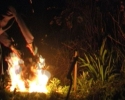
Annabelle Craven-Jones
from a question on disappearance, 2009
Single channel colour video with audio, 10:18 min, loop, edition 3+1 AP
Courtesy Cruise & Callas, Berlin
The work “form a question on disappearance” stems from a request by the artist to her father: to make a fire and to put it out just as soon as it is built. This process is visually seen in reverse whilst the sound follows the lapse of time. This relates to the psychological ‘unpacking’ of a mind, e.g. the ‘unpacking’ of past events, that is subjected to a course of therapy.
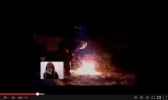
Annabelle Craven-Jones
unpack <from a question on disappearance>, 2012
Video with audio, 17:42 min, loop, edition 3+1 AP
Courtesy Cruise & Callas, Berlin
In 2012, the initial premise of the film "form a question on disappearance" has been reenacted remotely. The artist now gives the instructions per livestream via webcam. This re-enactment of the original work is subjected to a process, which the artist calls "unpacking". Here again, Craven-Jones uses a psychological working method which is translated into an aesthetic one. Therefore, the use of a livestream reflects on our constant switch between analogue and digital. The artist equally emphasizes the triangular structures, which can be found throughout the history of psychotherapy, and is also echoed in the relationship dynamic between the viewer, artwork and artist.
Tue, June 25, from 4pm to 8pm
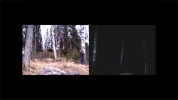
Annabelle Craven-Jones
AFFECTIVE AUTO STREAM (LIVE CONSCIOUSNESS), 2012
2 video loop, video 1: 4:01 min, video 2: 4:37 min, edition 3+1 AP
Courtesy Cruise & Callas, Berlin
The video “AFFECTIVE AUTO STREAM (LIVE CONSCIOUSNESS)” uses live streaming as an equivalent to stream-of-consciousness thinking. A site for the performance was chosen by physically running a 100 meter Ethernet cable from an indoor Internet hub into nature. The performance took place in both daylight (video on the left) and then at night (video on the right) where a Therapy Light provided the only light. The artist performs a repetitive act: She repeatedly walks between three birch trees in the form of a triangle. The performance indicates an internalized embodiment of the form: the triangle, which is a recurring motif in the artist’s work.
_still_web-c659557f.jpg)
Annabelle Craven-Jones
SOMEWHERE THERE IS THE SOUND OF SOMEONE THINKING IN A WOOD (GREY NOISE INVERSE), 2012
Single channel video with sound, 1:27 min, loop, edition 3+1 AP
Courtesy Cruise & Callas, Berlin
The video loop shows the artist repeatedly walking away from the laptop camera and disappearing into the Finnish forest. The laptop appears to be the only witness to this act of disappearance. Craven-Jones plays on the philosophical question, ‘If a tree falls in a forest and no one is around to hear it, does it make a sound?’ The soundtrack is an emission of digital grey noise, suggestive of the omnipresence of a Nordic winter grey, the sound of trees moving and the “sound of thinking” (Craven-Jones).
_still_web-f00957c2.jpg)
Annabelle Craven-Jones
PURE GREY LATITUDE SYNDROME (NORDIC), 2012
Screensaver with audio, 2:40 min, loop, edition 3+1 AP
Courtesy Cruise & Callas, Berlin
This artwork is conceived as a screensaver, which plays on the monotone voice found in therapeutic self-help recordings. Set in the context of a grey-clouded Finland, where this piece was made, the voice conflates this language with the condition and the nature of light itself. The image is reduced to the colours used for ‘pure screen tests’ in relation to the omnipresent greyness. Whilst the viewer looks at the suggestive change of colours, the text leads to a collapsing of definitions about the self-image.
Wed, June 26, from 4pm to 8pm
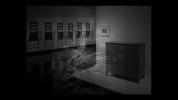
Alexandra Hopf
…oder sollte dies eine unbekannte Mauer sein?, 2008/2009
Video on DVD, 7:17 min, edition 5
Courtesy Cruise & Callas, Berlin
The video "…oder sollte dies eine unbekannte Mauer sein?" resembles an extensive personal atlas of pictures collected by the artist over the past few years. The single images are mounted together and are slowly dissolving into each other, generating afterimages that shine through like unconscious layers and merge with the act of seeing.
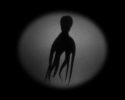
Alexandra Hopf
Illucid Cinema, 2010
Video on DVD, 11:40 min, edition 5
Courtesy Cruise & Callas, Berlin
The video "Illucid Cinema" is a montage of YouTube-clips which are ordered by the consecutive entry of certain search keys. The logical jumps that arise are similar to those in dreams. Whilst referring to the beginning of the medium film with its pinhole-like, b/w-appearance, the length of the video takes on the duration of the first phase in REM. The single sequences take only a few seconds, generating a stream of consciousness like in dreams, which simultaneously reflects on the production of the actual video.
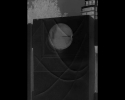
Alexandra Hopf (DE, 1968)
Miami Noir, 2012
Video on DVD, 7:47 min, edition 5
Courtesy Cruise & Callas, Berlin
In a somnambulistic slipstream of images showing inner and exterior spaces, the video "Miami Noir" animates some kind of shadow lands. Referencing the film noir genre with its contrast of light and shade and its b/w-scenery, the images create a dystopian portrait of the city of Miami.
Thu, June 27, from 4pm to 9pm - screening start every full hour
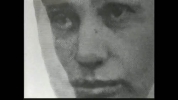
Kurt Kren (AUT, 1929-1998)
2/60: 48 Köpfe aus dem Szondi-Test, 1960
16mm, b/w, 5:03 min
Courtesy the artist
The b/w-photographic material of Kurt Kren’s structural movie "2/60: 48 Köpfe aus dem Szondi-Test" is taken from the Szondi test, a psychological exam to diagnose drive structures. The photographs of the different faces are mounted consecutively. Although eyes, noses and mouths are always placed at the same position, the quick succession of the different faces makes it impossible for the viewer to perceive the single faces as a whole. Due to the afterimages generated by the Phi-effect and the mathematically thought out combination of photos, the so called Szondi test becomes a test in perception.
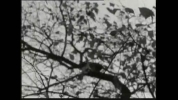
Kurt Kren (AUT, 1929-1998)
3/60: Bäume im Herbst, 1960
16mm, b/w, silent, 4:19 min
Courtesy the artist
Kren's film "3/60 Bäume im Herbst" also consists of b/w recordings, which are mounted together in a fast succession. Motives are trees in autumn. The unease of the shots creates a dramatic appearance, which is even more highlighted by a synthetically generated sound – a hand scribed soundtrack.
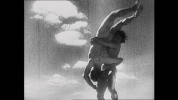
Peter Roehr (DE, 1944-1968)
Film-Montagen I-III, 1965
PAL, b/w, sound, 23:55 min
Courtesy estate of Peter Roehr and Mehdi Chouakri, Berlin
In “Film-Montagen I-III” Peter Roehr translates the aesthetic principle of his serially ordered text- and object-montages into moving pictures. Thefilmic sequences are taken from commercials, the weekly newsreel, thriller and horror films of the 1950s. The length of the short sequences surpress the construction of a narrative or plot and consequently make the individual cut visible as a single structural element. "I'm changing material, as I repeat it unchanged - The statement is: The behavior of the material on the frequency of its repetition." (Peter Roehr). The individual b/w-sequences, mostly not longer than 15 seconds, are repeated until they dissolve in their repetition. The temporal structure is related to the principles of serialism in music.
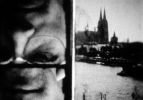
Birgit Hein (DE, 1942) & Wilhelm Hein (DE, 1940)
Rohfilm, 1968
Video, 22:00 min
Courtesy the artists
"Rohfilm" by Brigit and Wilhelm Hein examines the process of reproduction and the film as material itself. Guided by the interest of abstraction the experimental filmmakers deconstruct the ordinary film image, by mounting individual squads of existing 8mm and 16mm film strips in quick succession one behind the other, negating any narration or action. Instead, the raw physical aspect of the medium is emphasized: dirt, sprocket holes, cracks and scratches. Different image sizes, due to the change from 8mm to 16mm film, and the positive and negative images highlight the films structural composition and its purely physical and material presence.
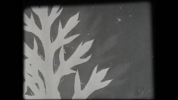
Annette Frick (DE, 1957)
Cosmic Elements, 2002
16mm, Lichtton, 6:00 min
Courtesy the artist
Annette Frick’s film “Cosmic Elements” uses the technique of photographic imaging, without which the medium of film and photography would not be conceivable. Using the rayography, where the image objects are placed in the darkroom on photo paper and illuminated by light, the plants themselves form the objects of the footage. Different tones of grey are created by disarranging the plants on the paper during the illumination process. This process captures the formal complexity of the plants while abstracting at the same time.
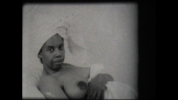
Annette Frick
Joyce in Preussen or Fürchte dich nicht Zarathustra, 2002-2004
16mm, Lichtton, 4:30 min
Courtesy the artist
“Joyce in Preussen” by Frick consists of handcrafted footage that shows a reenactment of the painting “Portrait einer Negerin” (1880) by Marie Guilleme Benoist as a recurring motif: It shows some a kind of archaic prehistoric woman, who is starring directly into the viewer’s eyes through the camera lens. In course of repetition of the motive, the attention of the viewer shifts from the object of gaze to the view itself.
Fri, June 28, from 4pm to 10pm
4pm and 7pm
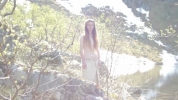
Markus Selg (DE, 1974)
Storråda, 2011
HD Video, sound, Blu-ray, 23:00 min, edition 5 + 2 AP
Courtesy the artist and Galerie Guido W. Baudach, Berlin
Starting point for Mark Selg’s film "Storråda" is the figure of the Nordic Queen Storråda. According to the myth, the Queen refused, for the sake of her husband's future to convert to Christianity - with far-reaching consequences. The beginning of Selg’s film is this dismissive “No!” What follows is the protagonist's path from the renunciation of society into a path of change. The film also formally turns away from narrative elements: Instead of the supporting actors from the beginning of the film we see Storrådas on her way through nature while its forms become more and more abstract. At the end the protagonist strips down her costume, and the film loses the last signs of the time in which it has taken its beginning. Thus, Storrådas path becomes an existential parable.
4.25pm and 7.25pm
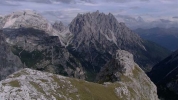
Susanne Kohler (DE, 1973)
Antlitz, 2011
HD Video with surround sound, 19:00 Min
Courtesy the artist
In the summer of 2009 the artist Susanne Kohler went on a three-month walk across the Alps, following a childhood memory of an echo, reverberating after 4 seconds. The direction of the hike was defined by the echoes, which lead the artist from the Valley of Passei across several ridges and glaciers to East Tyrol and finally to the Sextner Dolomites in Italy. On her journey she found twenty-two echo locations, resulting from the specific space, atmosphere and the reaction and the call of the artist, which form the sound of the video work. The scenes for “Antlitz” were filmed in the Dolomites, at the end of her three-month walk.
4.45pm and 7.45pm
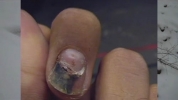
Brock Enright (US, 1974)
See Saw See, 2012
4:38 min, edition 5
Courtesy of the Artist and Kate Werble Gallery, NY
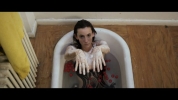
Brock Enright (US, 1974)
Eden-Study, 2012
5:46 min, edition 5
Courtesy of the Artist and Kate Werble Gallery, NY
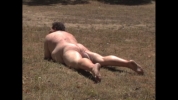
Brock Enright (US, 1974)
My Way, 2012
4:55 min, edition 5
Courtesy of the Artist and Kate Werble Gallery, NY
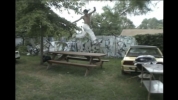
Brock Enright (US, 1974)
Limber Tricks, 40/a, 2005
7:26 min, edition 5
Courtesy of the Artist and Kate Werble Gallery, NY
„It is anarchy, in the truest sense“, states Brock Enright in an interview about his artistic work. In the video works we frequently see the artist himself, but also other persons, who seem to be very close to the artist, appear. As an object of his own work, the artist tries to forget conscious intentions and to focus on processes in his body to concentrate on the “what’s going on in [his] muscles” (Enright). The brutality of the physicalness in the works makes the viewer cringe; whereas the soundtrack of youthful imprudence collapses with the visual horror. Although the works create a terrifying image of an artist, who makes himself the object of his work (or has to), any bitterness is missing: just in their nonjudgemental “that’s how it is” the works develop their identity-establishing intensity.
5.10pm and 8.10pm
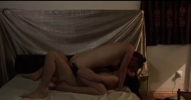
Sungeun Kim (KR, 1984)
A Voyeur’s Diary, 2013
Single channel video, 23:19 min
Courtesy the artist
The film “A Voyeur’s Diary” is a visual experiment in a form of video essay by Korean artist Sungeun Kim. The melodramatic correspondence of two lovers, which is subdivided into several chapters, is recited by a male and a female voice. We see scenes of universal character which could, as it seems, be everywhere – urban landscapes, the view out of a moving train, a bedroom. The insights granted by the artist become more and more intimate. Nevertheless, the film is penetrated with a feeling of alienation: from the inability to communicate between two individuals to a filmmaker’s unwilling detachment from her own creation and to the vulnerable relationship between images and memories. The story, inspired by the artist’s experience of shooting a pornographic film and her conflicted feelings thereafter, follows the psychological and emotional journey of a woman in love, mirroring the artist’s meditation on the filming process and conveying meanings in the images.
5.25pm and 8.25pm
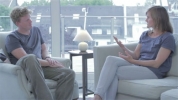
William Hunt (UK, 1977)
A Moment’s Hesitation, 2012
13:59 min
Courtesy Ibid Projects
As a performance artist William Hunt frequently puts his life to risk. The video “A Moment’s Hesitation" documents a press interview, which was hold between Hunt and his wife who is working as a journalist. The conversation starts in a journalistic-objective way about Hunt’s artistic practice, and it is during the course of the interview that it becomes apparent, that the two dialogue partner are in a relationship. The question why it is unavoidable for the artist to put a risk on his life in his artworks becomes more and more central during the conversation. The interview, which started out as a professional, distanced conversation of the two spouses gets more and more emotional and intimate during the course of the discussion.
6.05pm and 9.05pm
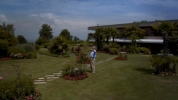
Gaëlle Boucand (FR, 1980)
JJA, 2012
HD, color, stereo, 50:57 min
Courtesy the artist and Red Shoes / SOME SHOES production
In her documentary the artist Gaëlle Boucand follows the narration of an 85-year-old man, whose isolated life in a luxury villa is monitored by surveillance cameras. The former businessman openly talks about his economic success and the reasons for his exile in Switzerland. The constant clashes with his business partners and the relationship to the place where he now lives, forms the style of his narrative, changing from day to day and from one room of his residence to the next. Time and again, the 85-year-old is looking on the same complexes of his past, questioning whether he truly arrived at a home in his high-backed existence.
Sat, June 29, from 4pm to open end
山海の珍味 - All kind of delicacies: Selected Japanese films curated by Frauke Boggasch
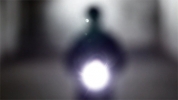
Frauke Boggasch (DE, 1975)
Geist, 2012 (with Endre Aalrust & Martin Sulzer)
Video, sound, colour, 6:40 min
Courtesy Cruise & Callas Berlin
The video work “Geist“, which was filmed in the actual basement of the gallery, shows the artist Frauke Boggasch frequently wandering around the dark space. Ghostly shadows appear sporadically around her – the ghost figures mounted into the video are taken from Japanese woodcuts. They consciously prevent the rise of illusion. The preoccupation with ghosts pervades Boggasch’s oeuvre, whose medium is mainly painting. Boggasch’s interest lies in the “personal ghosts” who haunt all of us, whether as personal memories or fears or, in particular as the embodiment of the artist’s ego, with whose influence, characteristics or cliché the artists deals repeatedly. By projecting the film at its actual setting Boggasch puts the viewer into her own physical space of action.
Cédric Dupire (FR?, 1979) & Gaspard Kuentz (1981)
We Don’t Care About Music Anyway…, 2009
Japanese with English subtitles, 80:00 min
"We Don’t Care About Music Anyway" is a documentary film that portrays a group of eight Japanese experimental musicians. The two French filmmakers make use of an extra ordinary way of constructing their film. The musicians infuse Tokyo with a symphony of sound, usually not related to one and another, but which is here compiled in a wonderful avant-garde way.
Kim Longinotto (GB, 1952) & Jano Williams (GB)
Shinjuku Boys, 1995
53:00 min
The documentary "Shinjuku Boys" is about three so-called "Onnabes,"* which work in a club in Tokyo as entertainers. The film shows them during their job and in private at home. All of them frankly speak to the camera about their transsexual lives and their positions on various issues that surround them.
* Onnabes are women living as men and and who are in a relationship with a female partner, but who do not consider themselves as lesbians.
Nobuhiko Obayashi (JPN, 1938)
House (ハウス Hausu), 1977
88:00 min
The Japanese horror film "House" deals about the schoolgirl Gorgeous, who visits with six of her friends the house of her aunt in the countryside during the holidays. There, things happen, of which none of the girls ever thought that they could: they experience the power of supernatural powers. And one after another is absorbed into the eerie house.
Nobuo Nakagawa (JPN, 1905)
Jigoku (Hell a.k.a. The Sinners of Hell), 1960
Colour, 101:00 min
“Jigoku” means hell in English. The film which is also known under the name “The Sinners of Hell” dissociates itself with its special visual material from other Japanese horror films of its time. “Jigoku” is about Shiro, a theology student from Tokyo. After a hit and run with his fellow student, he finds himself impossible to live on with his guilty conscience. Every time he thinks he could cleanse his conscience, another tragic moment comes in between. At the end Shiro ends up in hell where he meets his already deceased fiancée.
Masaki Kobayashi (JPN, 1916)
Kwaidan, 1965
161:00 Min
“Kwaidan” literally means ghost stories. The film rests on a collection of Japanese folk tales and consists of four individual stories: “The Black Hair,” “The Woman of the Snow,” “Hoichi the Earless” and “In a Cup of Tea.” The award-wining (Cannes) expressionistic film is often described as a horror movie, but it disclaims the usual shocking moments in favor of a slow and reluctant buildup of tension.
Frauke Boggasch & Martin Sulzer
Nachtparade, 2012-2013
In this row of short animations Frauke Boggasch and Martin Sulzer transfer Japanese anime-characters into german humoristic culture - a lovely and comical clash of two cultures.
